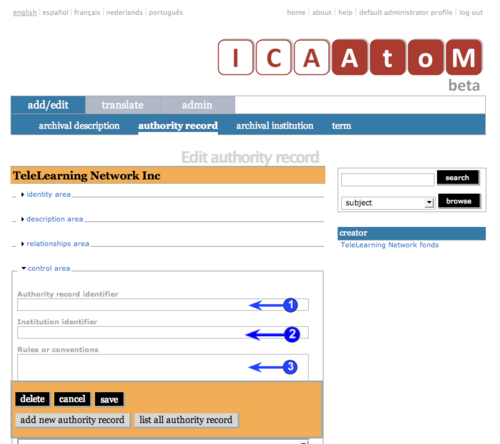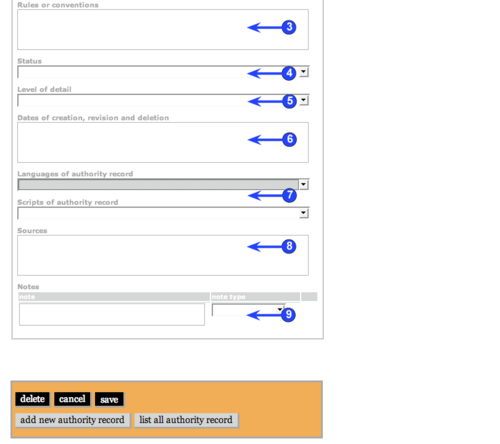Difference between revisions of "Control area"
| Line 37: | Line 37: | ||
| − | 6. '''Dates of creation | + | 6. '''Dates of creation and deletion''' |
*"Record the date the description was created and the dates of any revisions to the description. Specify in the ''Rules and/or conventions'' element ([[RS-3#5.6.3|5.6.3]]) the system(s) of dating used, e.g. ISO 8601." ([[RS-3#5.6.6|ISDIAH 5.6.6]]; cf. [[RS-2#5.4.6|ISAAR(CPF) 5.4.6]]) | *"Record the date the description was created and the dates of any revisions to the description. Specify in the ''Rules and/or conventions'' element ([[RS-3#5.6.3|5.6.3]]) the system(s) of dating used, e.g. ISO 8601." ([[RS-3#5.6.6|ISDIAH 5.6.6]]; cf. [[RS-2#5.4.6|ISAAR(CPF) 5.4.6]]) | ||
| Line 71: | Line 71: | ||
*Enter the ''note'', select the ''type of note''; when you save the record, ICA-AtoM registers the note and displays it in the list above the data entry fields. | *Enter the ''note'', select the ''type of note''; when you save the record, ICA-AtoM registers the note and displays it in the list above the data entry fields. | ||
| − | *'' | + | *''Maintenance notes'' are just one type of note that can be entered; the ''notes'' list will show '''all''' notes. |
| − | *There is no limit to the number of notes that can be added, but as of the current version of ICA-AtoM (v1.0 beta) you can only register them one at a time; i.e. enter the | + | *There is no limit to the number of notes that can be added, but as of the current version of ICA-AtoM (v1.0 beta) you can only register them one at a time; i.e. enter the data, click the ''save'' button and repeat for each additional note. |
*In [[Archival description|archival descriptions]] this [[Data element|data element]] is given its own [[Information area|information area]] ([[UM-3.1.9|see UM-3.1.9 Notes area]]). | *In [[Archival description|archival descriptions]] this [[Data element|data element]] is given its own [[Information area|information area]] ([[UM-3.1.9|see UM-3.1.9 Notes area]]). | ||
Revision as of 15:14, 15 July 2008
Please note that ICA-AtoM is no longer actively supported by Artefactual Systems.
Visit https://www.accesstomemory.org for information about AtoM, the currently supported version.
Data entry: control area
Main Page > (UM) User manual > UM-3 Add / edit content > UM-3.4 Data entry: control area
The control area is the same for archival descriptions, authority records, and archival institutions. It contains fields that uniquely identify the description itself and records how, when and by which archival institution the description was created and maintained.
The following notes aim primarily to clarify ICA-AtoM procedures; for guidelines on what information to record in particular fields, consult ISAD(G), ISAAR(CPF) or ISDIAH as the content standard. The notes are organized by field, with links to the applicable section(s) of the standards. Where there is a one-to-one correspondence between a data element in the standard and an ICA-AtoM field, the note simply gives the standard rule verbatim.
1. Description identifier
- "Record a unique description identifier in accordance with local and/or national conventions. If the description is to be used internationally, record the code of the country in which the description was created in accordance with the latest version of ISO 3166 Codes for the representation of names of countries. Where the creator of the description is an international organisation, give the organisational identifier in place of the country code." (ISDIAH 5.6.1; cf. ISAAR(CPF) 5.4.1)
2. Institution identifier
- "Record the full authorised form of name(s) of the agency(ies) responsible for creating, modifying or disseminating the description or, alternatively, record a code for the agency in accordance with the national or international agency code standard." (ISDIAH 5.6.2; cf. ISAAR(CPF) 5.4.2)
3. Rules or conventions
- "Record the names, and where useful the editions or publication dates, of the conventions or rules applied. Specify separately which rules have been applied for creating the Authorised form of name. Include reference to any system(s) of dating used to identify dates in this description (e.g. ISO 8601)." (ISDIAH 5.6.3; cf. ISAAR(CPF) 5.4.3)
4. Status
- "Record the current status of the description, indicating whether it is a draft, finalized and/or revised...." (ISDIAH 5.6.4; cf. ISAAR(CPF) 5.4.4)
- ICA-AtoM ships with a drop-down menu using values drawn from the description statuses taxonomy; administrators and editors can customize the taxonomy to meet institutional standards.
5. Level of detail
- "Record whether the description consists of a minimal, partial or full level of detail in accordance with relevant international and/or national guidelines and/or rules. In the absence of national guidelines or rules, minimal descriptions are those that consist only of the three essential elements of an ISDIAH-compliant description (see 4.7), while full descriptions are those that convey information for all relevant ISDIAH elements of description." (ISDIAH 5.6.5; cf. ISAAR(CPF) 5.4.5)
- ICA-AtoM ships with a drop-down menu using values drawn from the description detail levels taxonomy; administrators and editors can customize the taxonomy to meet institutional standards.
6. Dates of creation and deletion
- "Record the date the description was created and the dates of any revisions to the description. Specify in the Rules and/or conventions element (5.6.3) the system(s) of dating used, e.g. ISO 8601." (ISDIAH 5.6.6; cf. ISAAR(CPF) 5.4.6)
7. Language and Script
- "Record the language(s) and/or script(s) of the description. Include the appropriate ISO codes for languages (ISO 639-2 Codes for the representation of names of languages) and/or scripts (ISO 15924 Codes for the representation of names of scripts)." (ISDIAH 5.6.7; cf. ISAAR(CPF) 5.4.7)
- ICA-AtoM implements this data element as a two multi-value fields.
- Select language and script of the description from the drop-down menu; when you save the record, ICA-AtoM registers the language and script and displays them in lists above the data entry fields.
- There is no limit to the number of languages or scripts that can be added, but as of the current version of ICA-AtoM (v1.0 beta) you can only register them one at a time; i.e. select the language and/or script, click the save button and repeat for each additional language or script.
- Whenever you add a new translation of a description, the new language and/or script must be added to the list.
- To delete a language or script, click the delete icon.
- To add a narrative note relating to language or script, use the notes field.
8. Sources
- "Record the sources consulted in establishing the description." (ISDIAH 5.6.8; cf. ISAAR(CPF) 5.4.8)
- This is a text field; ICA-AtoM does not structure the data in any predetermined way.
9. Maintenance notes
- "Record notes pertinent to the creation and maintenance of the description. For example, the names of persons responsible for creating and/or revising the description may be recorded here." (ISDIAH 5.6.9; cf. ISAAR(CPF) 5.4.9).
- ICA-AtoM implements this data element as a multi-value field.
- Enter the note, select the type of note; when you save the record, ICA-AtoM registers the note and displays it in the list above the data entry fields.
- Maintenance notes are just one type of note that can be entered; the notes list will show all notes.
- There is no limit to the number of notes that can be added, but as of the current version of ICA-AtoM (v1.0 beta) you can only register them one at a time; i.e. enter the data, click the save button and repeat for each additional note.
- In archival descriptions this data element is given its own information area (see UM-3.1.9 Notes area).

